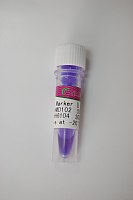Oligonucleotide PRINS DNA Synthesis on Extended Chromatin Preparations
互联网
520
One of the inherent problems with conventional fluorescent in situ hybridization (FISH) on metaphase chromosomes has been the difficulty in resolving closely associated markers. Any targets separated by less than about 1 Mb (1 � 106 bp) tend to appear as a single locus on metaphase chromosomes. The first approach to improving this resolution was hybridization to interphase nuclei (1 ,2 ), in which, because the chromatin is decondensed, the markers are further apart and, therefore, more easily resolved. However, the chromatin in interphase nuclei is not identifiable as discrete strands, so it is both difficult to see whether two markers are definitely linked and impossible to tell whether, if they are physically linked, the chromatin between them follows a straight course or a convoluted one. Thus, it is necessary to measure the distance between a large number of signal pairs to establish modal and average figures for the distance between them. By this means, it has been possible to establish physical distances between markers as little as 50–100 kb (5 � 104 –105 kbp) apart.






